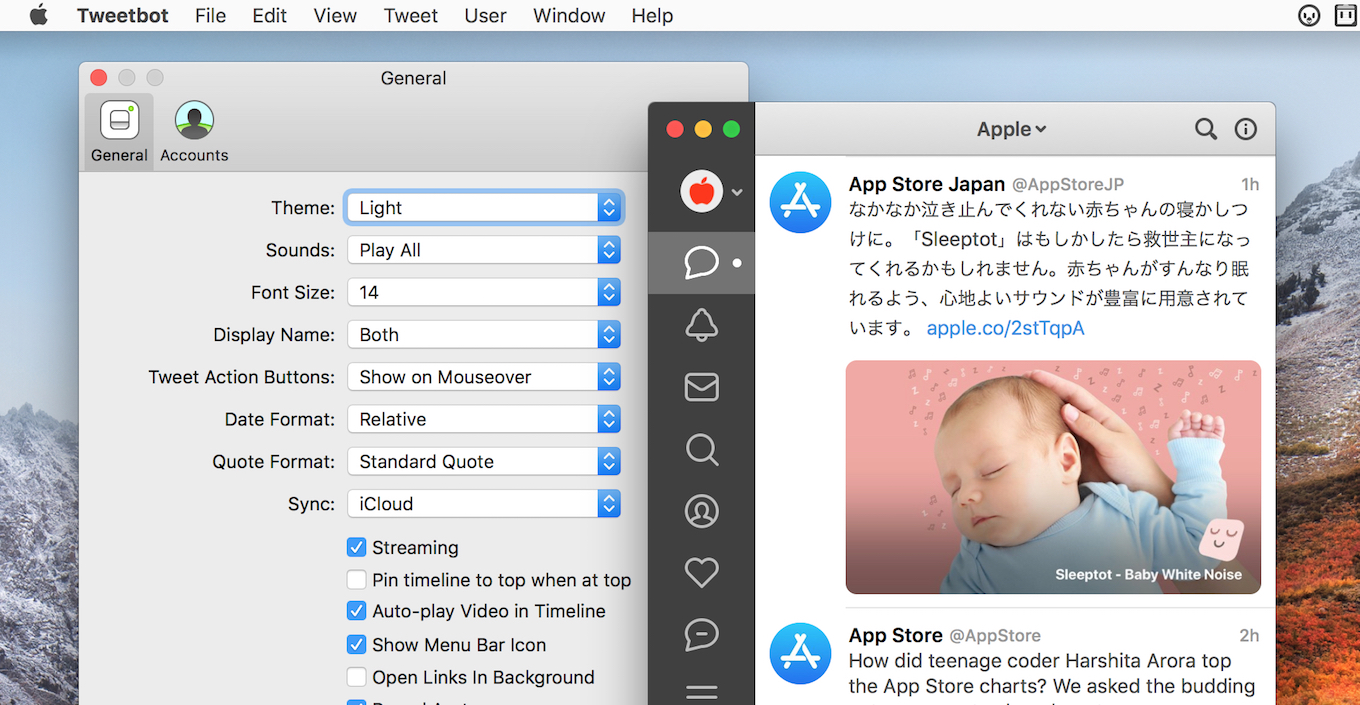Tweetbot is an award-winning, full-featured* Twitter client for the Mac. It has a beautiful interface with light & dark themes, multiple-column support and much more. * Twitter does not grant 3rd party apps access to every single feature that is available on Twitter’s website.
Tweetbot is a full-featured OS X Twitter client with a lot of personality. Whether it’s the meticulously-crafted interface, sounds and animation, or features like multiple timelines and column views, there’s a lot to love about Tweetbot. Features.
Drag & Drop Columns. Columns have been redesigned from the ground up to be faster and easier to use.
Just drag the column circle to the right to add columns and back to the left to hide them. Columns persist even when hidden. Better Media. Automatically play videos and GIFs in your timeline with a quick mouseover. A click on media opens it up in our lightning fast new media viewer.
Timeline Filters. The powerful timeline filters from Tweetbot for iOS are finally on the Mac. Quickly filter a timeline to show only tweets with media, retweets, links, or create your own keyword or rules-based filters. Mute Filters.
Hide Tweets in your timelines by specific users, keywords, hashtags, or even the client that published the Tweet. Create limited time filters to avoid spoilers for upcoming blockbuster movies or sporting events. Full support for managing your Twitter lists.
Use them as custom curated timelines or even as your main timeline. Notifications.

Tweetbot 4
View your mentions and activity in a combined view or separately under the new notifications tab. Tweet Topics. Topics automatically chain together multiple Tweets to easily create tweetstorms or live blog events.
Tweetbot App
Multiple Accounts. Quickly switch between multiple accounts via the quick account picker, menu bar or keyboard shortcuts. Open them in separate windows or full screen spaces. Quick Paste Links.
Paste Tweet or profile web links directly into Tweetbot to view them instantly.
Did you know there is a twitter account that will tweet when a connect item is closed or resolved as fixed? I first heard about this account at the Pass Summit last week, then I promptly forgot about it. This morning I was listening to SQL Server Radio, in this show the hosts Matan Yungman and Guy Glantser were talking about this twitter account. I decided to check out this account and follow this account Here are some examples of tweets from the twitter account Publishing dacpac to SQL Database fails when database uses memory optimized features & target database is in database pool. After you have created your ODBC data source, you need to load the (RODBC) package, create a connection, execute a query, display the results and close the connection. Here is what it looks like in the R Console require(RODBC) db Sample head(Sample) close(db) #close ORDBC connection name id xtype uid info status baseschemaver 1 spMSalreadyhavegeneration - P 4 0 0 0 2 spMSwritemergeperfcounter - P 4 0 0 0 3 TABLEPRIVILEGES - V 3 0 4 spreplsetsyncstatus - X 4 0 0 0 5 spreplshowcmds - P 4 0 0 0 6 sppublishdb - P 4 0 0 0. 1 RT @rquintino: @MairosB #sqlsatportugal session: all about R in #SqlServer 2016 #rstats 2 a quick script to use imgcat in #rstats 3 RT @KirkDBorne: Useful packages (libraries) for Data Analysis in R: #DataScience #Rstats by @analyticsvidhya https: 4 Hey #rstats tweeps, do you have any readings to recommend on sensitivity analysis?
Books/articles/websites all welcome. Make sure that you have append = TRUE, if you make it FALSE, the table will be recreated every time but since the command issued creates the wrong data type for the created column, you can't use it So to recap, here are the commands you need after you loaded the twitterR package and have setup OAuth tweets twListToDF(tweets) #convert to dataframe require(RODBC) # load RODBC package db sqlSave(db,append = TRUE,colnames = FALSE,verbose = FALSE, addPK = FALSE, twListToDF(tweets)) #insert data into your table close(db) #close ORDBC connection.